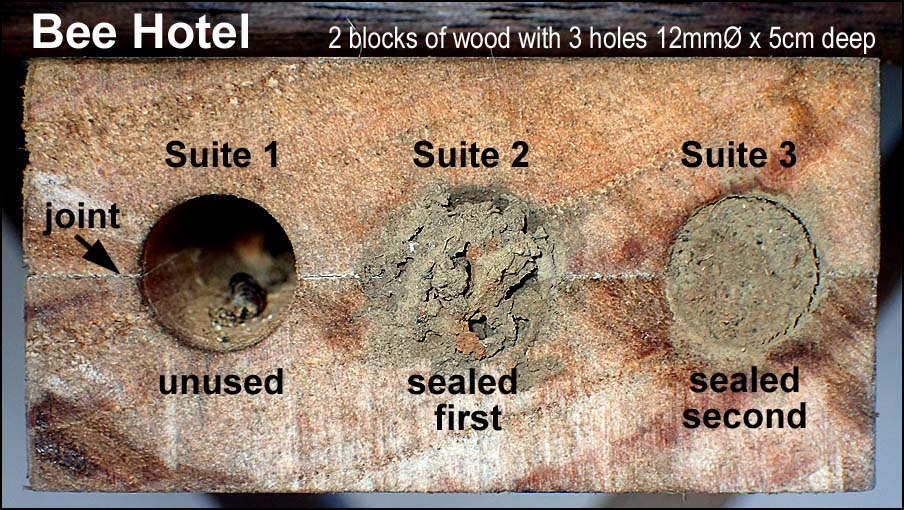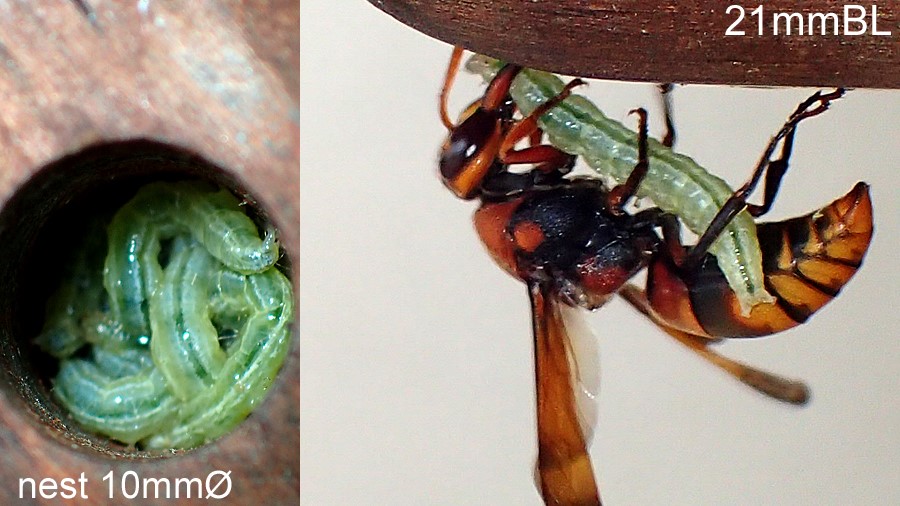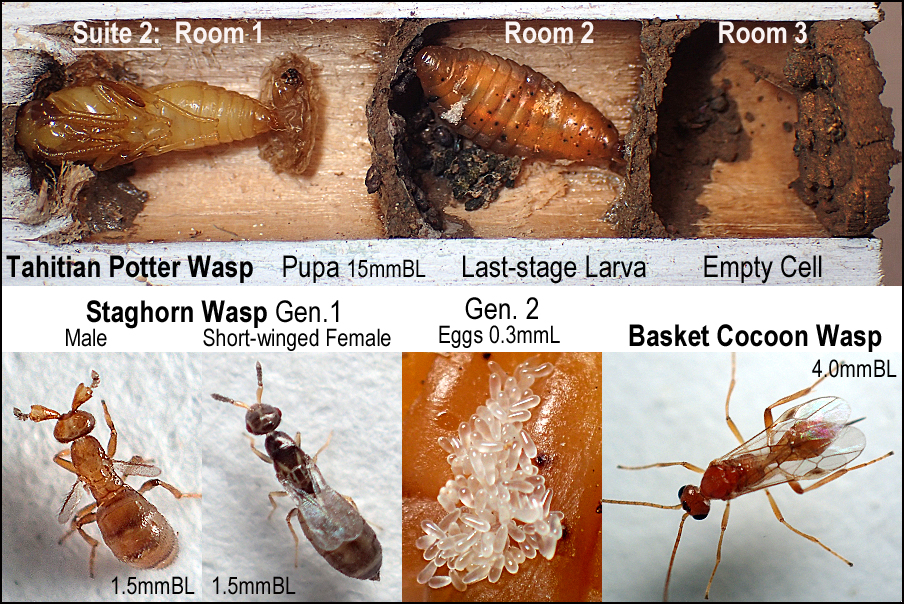Life in the Karekare Bee Hotel
Saturday 12 February 2022 | Written by Supplied | Published in Environment, National

PHOTO: JUNGLEFARM/22021145
Cook Islands Natural Heritage Trust’s Gerald McCormack writes about the complexities of life in a bee hotel in Karekare.
We built a small hotel to study the behaviour of the local Leaf-cutter Bee, which usually nests around March or April. The hotel had three 12 millimetre holes about 50mm long drilled to overlap two blocks of wood so that separating them would open the holes for inspection. As a hotel, each hole is a suite and any occupying bee or wasp makes its own rooms by building partitions or doors. Within a suite, Room 1 is the first to be partitioned and will contain the oldest offspring.
Early morning on the 28th December it was unexpectedly noticed that a large Tahitian Mason Wasp had already sealed Suite 2 with mud and was starting work on Suite 3, which she sealed in the early evening. Suite 1 remained vacant. Twelve days later, on the 9th January the hotel was opened for inspection.
The first surprise was that Suite 3 which she worked on during the 28th contained two empty rooms. The purpose of creating a suite of empty rooms is unknown. Was she expecting the fresh doors to attract door-boring parasites away from her young in Suite 2? Had she run out of eggs to lay?
In Suite 2 she had created three rooms. In Room 1, the oldest room, there was a live pupa, while Room 2 contained a dead larva killed by parasites, and Room 3 was empty. We will discuss the occupants of the hotel, including an accidentally imprisoned guest.

Tahitian Potter Wasp
The dark brown and yellowish-banded Tahitian Potter Wasp (Rhynchium quinquecinctum tahitense) was first recorded on Rarotonga in 2014 by the Trust and on Ātiu in 2020 by Roger Malcolm. It is surprising it had not arrived much earlier considering it was recorded in the Society Islands 150 years ago and it often builds its nests in transportable objects.
It is now widespread on Rarotonga and very conspicuous because of the queen’s large size (21mmBL) and her persistent nesting activity. She is a solitary wasp which means she nests alone and is both the egg-laying queen and the worker. She is also a tube-renter because she nests in an existing tube instead of building an entire nest of mud.
After selecting a suitable tube, she can build a wall to make it shorter, or, as in the case of our hotel suites, she smoothed the end with some mud. She then hunted caterpillars which she paralysed with her stinger and stacked into the end her nest. When she had provided enough paralysed food for her offspring to fully develop, she laid an egg and sealed the room with a mud door, a millimetre or two thick.
Within Suite 2 of our bee hotel she provisioned the two inner rooms, but left the outer room empty. The outermost door was more substantial at about 3mm thick to better exclude her enemies. Alas, sometime before the 28th December she noticed drying cracks in the outer door so she added some thick strands of mud to conceal or reseal it. (See Bee Hotel photo.)
On opening the hotel on the 9th January, Room 1 of Suite 2 contained a live pupa which a week later on the 16th transformed into an adult male potter wasp. This new male was unexpected, because the literature shows that related mud-wasps have the larger, slower-developing female offspring in the innermost rooms and the smaller, faster developing males nearer the suite entrance. In this way the males emerge a little ahead of their sisters and are ready to mate. The sisters are all future queens and they store sperm in a special sac to use selectively to fertilise some eggs to grow into females, and not fertilise others to make males. Why our queen made her first born a male is unknown – a mistake or a preference for sons?

Staghorn Wasp
Unfortunately for our potter wasp queen, her younger child was killed by parasites in the final stages of being a larva. The killers were a family of tiny wasp larvae of a species first found on Rarotonga by 5-year old Keanui Selam in 2020 in a Leaf-cutter Bee nest in this same hotel.
Keanui’s tiny parasitic wasp was an unidentified species in the genus Melittobia, the first species recorded in tropical Southern Polynesia. The males of the genus have very conspicuous antler-like antennae so we will call them Staghorn Wasps.
The Staghorn Wasp is a parasite which is more correctly known as a parasitoid because it always kills its host, while typical parasites, such as fleas and gut worms, do not kill their hosts. Furthermore, its larvae consume the host from the outside as an ectoparasitoid, rather than internally as an endoparasitoid. Staghorn wasps are widely recognised as invasive pests because they kill leaf-cutter bees which are important pollinators of flowers.
Each Staghorn Wasp colony is founded by a long-winged flying queen which chews her way into the host’s nest and injects a late-stage larva to prevent it pupating. She then lays her eggs on its skin and the emerging parasitoid larvae feed on the host larva to grow into flightless males and females, about 1.5mm long. The males, which are also blind use their large antler-like antennae to fight their brothers, while they exude a scent that has their sisters lining up to mate.
The flightless females are imprisoned queens to expand the colony. As the colony matures almost all eggs will develop into long-winged females, which after mating chew their way out of the nest and fly away to establish new colonies on the larvae of other unlucky large wasps.
The situation in our bee hotel was rather different to the textbook. When the hotel was opened on the 9th January, I did not see the founding Staghorn queen, which might have escaped unnoticed. I was surprised to find two generations of her offspring. The older generation of her children consisted of nine adult short-winged females and five antlered males, while the second generation of her grandchildren consisted of about a hundred eggs and a few young larvae on the skin of the potter wasp larva.
A possible explanation for this situation is that the founding Staghorn queen entered the room before the door was closed and, because there was no host larva available, she laid her eggs on a paralysed caterpillar where they grew into the few female and male adults. In the meantime, the mason wasp larva ate enough paralysed caterpillars to grow to its final or pre-pupal stage. At this point, the Staghorn founding queen stung the large host larva to arrest its development and her now mated, adult daughters laid dozens of eggs on the arrested pre-pupal larva.
In this proposed explanation the potter wasp would have had to close the nest around the 20th December to enable enough time for its young to be a large pre-pupal larva by the 9th January. And 20 days would also have been enough time for the tiny children of the Staghorn queen to grow into adults and lay dozens of eggs on the potter wasp larva.

The accidental guest
The accidental guest was a Basket-cocoon Wasp (Meteorus pulchricornis), which was first recorded in the Cook Islands by Maja Poeschko in 2005. It was originally described in Europe where it is a biparental species with males and females. It is biparental in much of Asia, but in some areas the population is uniparental with females breeding by virgin birth.
They arrived in New Zealand in the early 1990s and are now widespread, and they are a uniparental all-female population. The few recorded in the Cook Islands have also been females, so it is very likely that our population is also uniparental.
Basket-cocoon Wasps are internal lethal-parasites or endoparasitoids on caterpillars. They use their hollow spear-like ovipositor to deposit an egg (ova) into a live caterpillar. The egg develops into a larva which consumes the caterpillar from the inside before emerging to hang by a thread from a leaf while it weaves an oval cocoon around itself. In this hanging basket-like cocoon it transforms into an adult wasp – a female wasp, a clone of its virgin mother.
In the case of our bee hotel, the potter wasp queen paralysed a caterpillar that happened to contain an egg or larva of a Basket-cocoon Wasp. It placed the caterpillar into its nest as food for its own larva. Fortunately, the caterpillar containing the Basket-cocoon Wasp larva was not chewed up by the potter wasp larva.
The literature indicates that Basket-cocoon Wasps take about two weeks from egg to adult which means that, if our potter wasp sealed the room around the 20th December, it probably emerged from its cocoon around the 3rd of January. With no way to escape, this accidentally entrapped guest had to wander around in the dark without food or water for several days before I released it on 9th January. If that had not happened, it would have had to wait at least another week for the male potter wasp to emerge from its pupa and eat its way out of the suite.
Such are the complexities of life in a bee hotel in Karekare.












































